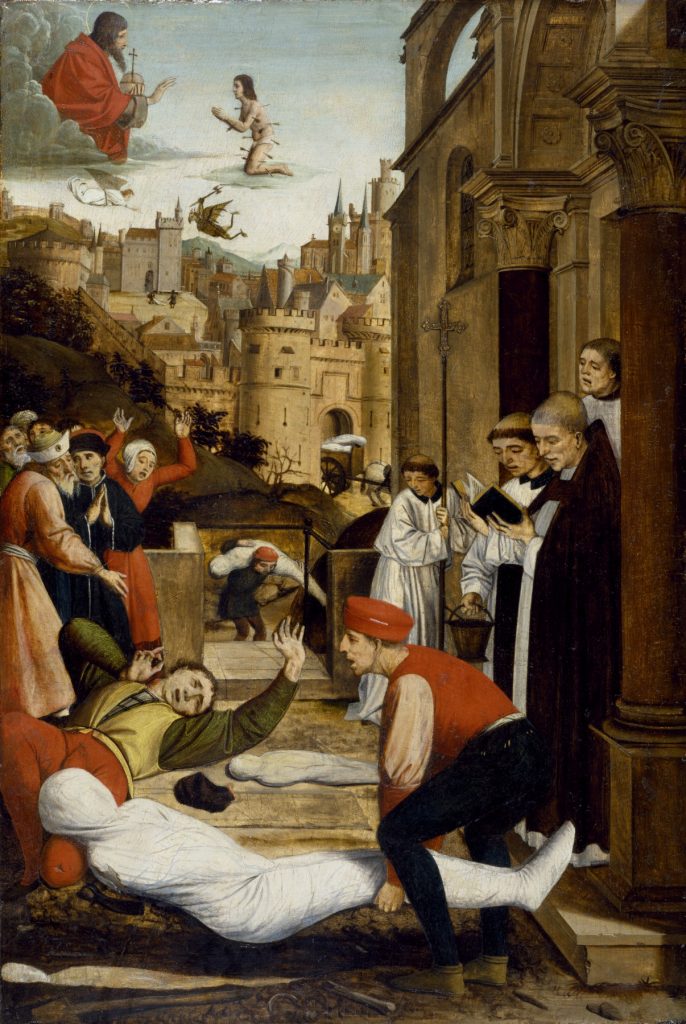There have been many epidemics that have plagued our planet over the last few thousand years; some, however, were more devastating than others. Epidemics often cause major disruptions in a society, besides simply killing people. They affect the amount of people in the workforce, which in turn can disrupt the production of goods and the food supply needed for a society.
The famous Bubonic Plague killed around a third of the population of Europe in the 1300s. The population of Europe in 1340 was about 73.5 million, and the plague affected over 20 million people. Today, Europe’s population is 508,450,856, meaning that if the plague were to have the same effects today as it did in the 1300s, it would kill around 102,000,000 people!1

The Bubonic Plague originated in the fleas carried by rodents like rats, squirrels, and prairie dogs, which transmitted the disease from one to the other. The disease spread from southwestern China to eventually the Black Sea ports of Caffa and Tana by 1346, and by 1348 it had reached northern Europe.2 The disease caused about the same symptoms in all of its victims, such as a fever, and pain so strong that they were not able to keep down any food. The name of this disease came from the fact that the people would become covered in black boils that oozed puss and blood.3 The photograph to the right is an exhibit at the Eyam Museum showing what an infected person would have looked like. The disease was highly contagious and was deadly because it worked so quickly; its victims could have been healthy one day and gone the next.

This image is of a doctor’s mask, which is similar to the masks that doctors used during the plague. These masks were believed to have protected them from breathing in the infected air. However, the masks were not very effective since many doctors contracted the disease.
This epidemic did not affect European countries in just one way, it caused major problems in many aspects of life for many areas. The continent had been battling famine and food shortages before the plague struck; then afterwards it left them in an even more compromising situation. There was a shortage of workers in the workforce, which meant that all aspects of production were affected, from food to goods and services. Try to imagine one third of the people you connect with on a regular basis completely gone. That would be a third of all the doctors, the workers you’ve encountered at the grocery store, a third of all the teachers, and even a third of one’s entire family. While this is happening, one’s entire country might already be going through a devastating famine. It is incredible that Europe was able to recover from this disaster and now has one of the largest populations in the world. The continent was able to recover from losing over a third of its population, in one of the most notorious epidemics in our world’s history, and now thrives as a largely populated and diverse part of the world.
- Josiah C. Russell, The Fontana Economic History of Europe, Vol. I: The Middle Ages, “Population in Europe,” (HarperCollins Distribution Services, 1972); European Union, “Living in the EU,” Europa.eu. (accessed November 2, 2016), http://europa.eu/european-union/about-eu/figures/living_en#tab-1-3. ↵
- Jerry H. Bentley, Herbert F. Ziegler, and Heather E. Streets-Salter, Traditions and Encounters: A Brief Global History Volume 1. 4th ed. Vol. 1. (McGraw Hill Education, 2016), 333-336. ↵
- McClain, Charles. “Of Medicine, Race, and American Law: The Bubonic Plague Outbreak of 1900,” Law & Social Inquiry 13, no. 3 (1988): 447-513. ↵



58 comments
Alejandro Garza
Interesting article that effectively captures the scope of how much of an impact the Bubonic Plague had on Europe in 14th century. Just imagine the impact it would have in the modern world; the workforce would be severely hurt to the same degree as back then or even worse. It’s really frightening that such an epidemic could occur again in modern times anywhere in the world and spread even quicker and farther thanks to how globally connected we are.
Luke Trevino
The bubonic plague is a real tragedy in all human history! The thing that caught my eye was the comparison of what it would of done today in Britain, a real eye opener! It is truly amazing that the society was still able to recover after such a heavy loss to their people. All in all, very well written and informative essay!
Teresa Valdez
I had no idea what the extent of the damage that the Plague had done. I can’t imagine what kind of damage that kind of population loss would do to our society today. The article does a great job on relating the effect of the plague to the present. It is quite baffling that Europe was able to bounce back in the way it did.
Sergio Cervantes
This article was well-organized and informative. I knew very little of the Bubonic Plague except that it had killed a colossal amount of people. The image of the mask doctors used to protect themselves proved helpful as I read. I did not know of the origins of the disease, nor where it came from. It also surprised me at how fast a disease can travel amongst peoples and cause a high amount of deaths. The damage report as to how many people died from this disease was saddening, especially when you mentioned that a third of the people I met would be dead.
Mario Sosa
It is very surprising how Europe was able to recover after losing one third of the population! A disease that can kill you over the course of one day is indeed frightening. The photos really captivate the horror of the Bubonic plague. I could not even begin to imagine if an epidemic with the same strength as the Bubonic Plague were to spread in the present day. This is a very fascinating article.
Nicolas McKay
This was a great article. It is so crazy to to think that millions of people were so healthy one day and could die of illness the next. I could never imagine a devastating disease like this occurring in today. Great job with your first picture, it was incredible to actually see what some with the black plague would have looked like.
Erik Rodriguez
Dang! That is just insane! I could not imagine experiencing that and seeing a third of the people I know just pass away instantly! The image you gave of the man in the museum is just brutal! Not to mention the doctors mask, that is just crazy. It is astonishing, however, that Europe was able to recover quickly and still be one of the worlds leading population. At this point of time, we can only appreciate that nothing of this degree has happen recently.
SUPER interesting and well written article, great job!
Aaron Jaramillo
Good article. What an impact it had on the Europe by affecting one third of its population. The most interesting to me was the doctors masks that they used to keep themselves from being infected. I did end the article with a question; What measures where taken by the Europeans to recover and thrive again after the epidemic.
Rafael Ortiz Salas
I always like reading about the effects the Bubonic Plague had in Europe. It was interesting that you compared the effects of the Plague to today’s population. I didn’t have an idea that of how many people would have been killed if it happen today. Very good article!! 😉
Nathan Cantu
This is very eye opening to image a plague like the Bubonic Plague, to occur in our life time on any major continent. The effects that it would have or the amount of people it would effect would be enormous because of the size of the worlds populations today and how much we interact with each other, on a day to day basis. Very hard to image if another plague were to come about in our lifetime.